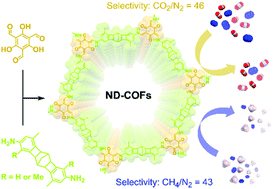Norbornane-based covalent organic frameworks for gas separation†
Abstract
Covalent organic frameworks (COFs) have emerged as a new class of crystalline porous materials with distinct structural features, such as uniform pore distribution, tunable architecture, and modifiable skeletons. COFs hold significant promise for application in gas separation because of their high Brunauer–Emmett–Teller surface area and narrow pore-size distribution, which enable selective separation. The porosity and separation performance of COFs have been finely tuned by structurally modifying the starting materials. Along this direction, for the first time, we prepared W-shaped diamines by catalytic arene–norbornene annulation (CANAL) and then treated them with trialdehyde (Tp) to synthesize novel β-ketoenamine-linked norbornane-based COFs, i.e., ND-COF-1 and ND-COF-2, via a solvothermal Schiff-base condensation approach. The pore interior was decorated with methyl groups attached to the norbornane unit of the COF skeleton. Both COFs exhibited high chemical stability in different organic solvents and acidic media. Additionally, they showed high CO2/N2 selectivity compared with those of previously reported COFs. Moreover, their CH4/N2 separation efficiency was investigated, and the results revealed that ND-COF-1 is more selective than ND-COF-2, which could be attributed to the less hindered pathway offered to methane gas molecules by the framework pore.

- This article is part of the themed collection: Nanoscale Most Popular 2022 Articles


 Please wait while we load your content...
Please wait while we load your content...